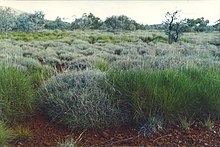Triodia (plant)
| Triodia | |
|---|---|
 |
|
| Triodia pungens (green) and Triodia basedowii (blue-grey) | |
| Scientific classification | |
| Kingdom: | Plantae |
| (unranked): | Angiosperms |
| (unranked): | Monocots |
| (unranked): | Commelinids |
| Order: | Poales |
| Family: | Poaceae |
| Genus: |
Triodia R.Br. |
| Synonyms | |
|
Plectrachne Henrard |
|
Plectrachne Henrard
Triodia is a large genus of hummock-forming bunchgrass endemic to Australia. They are known by the common name spinifex, although they are not a part of the coastal genus Spinifex. Many of the soft-leaved members of this species were formerly included in the genus Plectrachne.
Triodia is a perennial Australian tussock grass which grows in arid regions and has -shaped, pointed leaves. The leaf tips (high in silica) can break off in the skin, leading to infections. Leaves are 30–40 centimetres long.
Spinifex has traditionally had many uses for Australian Aborigines. The seeds were collected and ground to make seedcakes. Spinifex resin was an important adhesive used in spear-making. Smoke signals were made to communicate with families and groups a long distance away, as burning spinifex produces a strong black smoke.
The species Triodia wiseana is used for building shelters; bunched together it is used for trapping fish against creek beds. It is called baru in the languages of the Yindjibarndi and Ngarluma people, the English term is hard spinifex.
Species currently include:
Numerous species once considered members of Triodia have been reclassified, they are in other genera, which include: Austrofestuca, Chascolytrum, Danthonia, Dasyochloa, Deschampsia, Diplachne, Disakisperma, Erioneuron, Gouinia, Graphephorum, , , Plinthanthesis, Poa, Puccinellia, Rytidosperma, Scolochloa, Spartina, Torreyochloa, Trichoneura, Tridens, Triplasis, Tripogon, and Vaseyochloa.
...
Wikipedia
